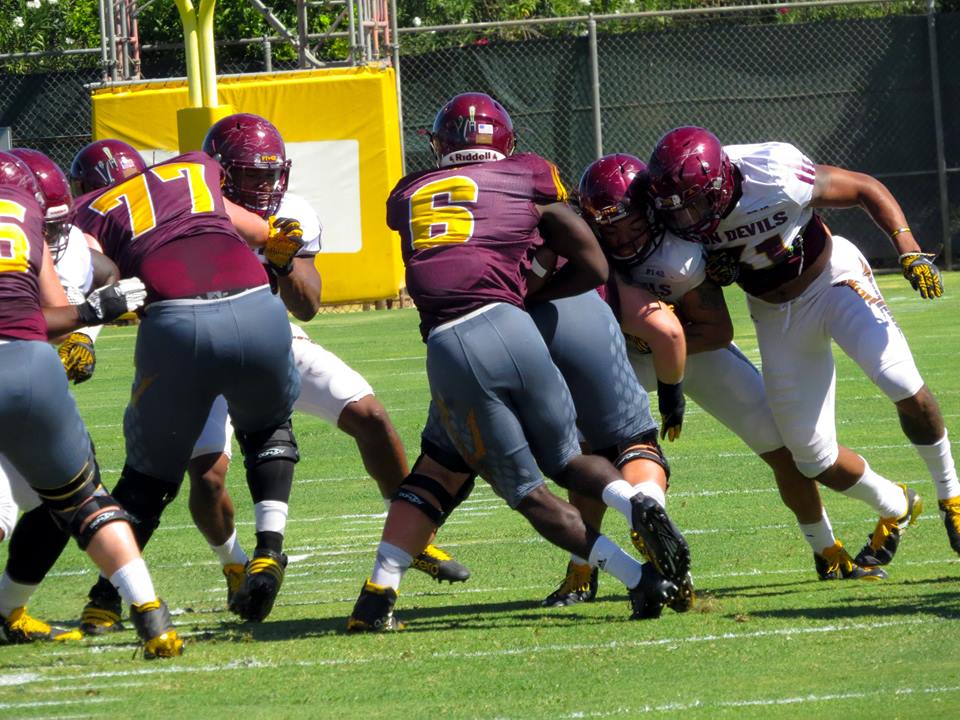
(Photo: Nicholas Badders/WCSN)
It’s easy to scapegoat Arizona State’s defense as the exclusive cause for the program’s losing season in 2016.
Plenty have done so, citing the team’s oft-maligned, blitz-happy scheme and nation-worst pass defense as the reason for the Sun Devils’ disappointing 5-7 record last fall.
However, an inability to stop opponents was only part of the problem. The Sun Devils’ offense, for all of its talent and potential, suffered from inefficiency and inconsistency, issues that handicapped the team’s ability to keep pace against Pac-12 opponents.
On the surface, the Sun Devil offense put up respectable stats:
Their 390 yards per game ranked 81st in the nation; a scoring average of 33 points a night was 40th in country.
But these numbers don’t tell the whole story.
More analytical metrics expose that while the Sun Devils could fill the stat sheet, their offense more-often hindered the team’s ability to win.
The unit ranked 96th in “offensive efficiency” in 2016. Their rushing attack was 112th nationally in yards per game and 119th in yards per carry. The offensive line was graded to be one of the worst in the country in both pass and run blocking.
All of these factors forced the Sun Devils to play from behind the eight ball, constantly trying to catch up to teams late in games. In 2016, ASU led after the first quarter only four times; they led at halftime just twice.
Unsurprisingly, quarterback Manny Wilkins threw more passes in the fourth quarter of games last year than any other quarter, usually in an effort to overturn a multi-score deficit.
ASU’s returning starting quarterback however, sees his team beginning to better utilize its weapons.
“Everybody has a job. People are going to be used in different situations. We have a lot of talent on the outside, we have a lot of talent at the running back position,” Wilkins said. “We got a lot of talent at tight end too. It’s really just about game planning, knowing when to use certain guys and I think we are doing a really good job of it.”
A relatively new stat kept in college football is “successful play rate,” classified as when a team gets 50 percent of the yards needed to move the chains on first down, 70 percent of the yards on second down, and convert on third down. A team with a high successful play rate usually keeps itself in good down and distances to help piece together long drives.
ASU ran successful plays just 37 percent of the time last year, one of the worst rates in the country.
A rejuvenated offensive line is trying to rewrite the team’s recent offensive struggles this season however, meshing as a unit and with its running backs to try and keep the Sun Devil attack on schedule.
“The offensive line is the engine of the team,” guard Steven Miller said. “In order to be good we’ve got to have a good offensive line; can’t be productive if you don’t have a good offensive line.
“It’s important to get those first (downs), get a second-and-six, something positive, rather than being in a second-and-thirteen.” he added. “You never want any of that.”
Miller, a redshirt sophomore out of Gilbert High School, is one example of the new blood ASU have infused into its front five this fall. Last year, Football Outsiders ranked the Sun Devils’ offensive line as the 112th group in the nation in “adjusted line yards” (a stat measuring how much an offensive line aids its running game) and 120th in “adjusted sack rate.”
This year’s group is confident it can reverse those trends, however, a necessary improvement for ASU to become a more dynamic offense.
“We’ve moved some guys around, shifted guys around just to see how we mesh, and for the most part we are a closer knit group this year,” Miller said of the front five. “The ability to mesh has been pretty easy, we’ve got a lot of smart guys that can communicate, do things from different positions and they know what they are doing.”
The rushing game would be the biggest benefactors from improved, and more versatile, play along the line. Even with the talented duo of Kalen Ballage and Demario Richard last year, the Sun Devils averaged just 3.32 yards per carry.
At the beginning of a new season though, there is confidence that the skill in the backfield will be showcased on an every-down basis.
“They’re great,” Miller said of the rushers. “It gives you motivation, you want to spring them open, give them a little space, and let them work because you know what they can do in open space.”
With the start of the 2017 campaign a little more than a week away, the Sun Devils will need their offensive offseason improvements to be realized. They’ve shown their abilities in short bursts, but as the group’s quarterback put it, this season’s focus is on making it happen every snap.
“It’s about going out there and executing,” Wilkins said. “We are putting in a game plan now so it’s just about taking advantage of every rep. You don’t get those reps back so every (one) really counts.”


